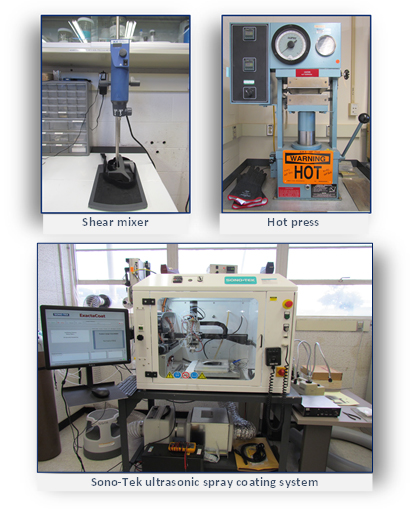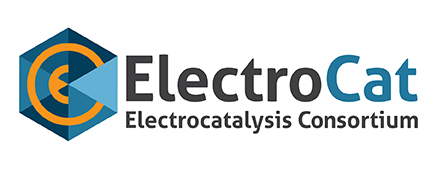| Laboratory: | Los Alamos National Laboratory (LANL) |
| Capability Expert(s): | Hoon Chung and Natalia Macauley |
| Capability Details: | |
| Title: | PGM-free MEA fabrication |
| Class: | Manufacturing |
| Description: |
Fabrication of PGM-free catalyst membrane-electrode assemblies (MEAs) involves three essential steps: (i) catalyst ink optimization and preparation, (ii) catalyst layer deposition onto the polymer electrolyte membrane to obtain a catalyst coated membrane (CCM) or onto the gas diffusion layer (GDL) to obtain a gas diffusion electrode (GDE), and (iii) integration of all required components into an MEA. Among the many factors directly impacting PGM-free catalyst ink properties, all inks require homogeneous distributions of the ionomer and the catalyst in the ink by using either an ultrasonic bath or a shear mixer. Once fully optimized, the ink is applied to the appropriate substrate. Especially for larger electrodes, a Sono-Tek ultrasonic spray coating system is used. Advanced MEAs are fabricated by hot-pressing the CCM, the cathode GDL (alternatively, a non-PGM GDE and a membrane), and the anode (usually a commercial Pt GDE) in a hot press. CCM or GDE manufacturing is a key step in MEA fabrication process. The Sono-Tek ultrasonic spray-coating system offers numerous controls for the electrode structure optimization. For example, two different 120 kHz nozzles, Accu-Mist and Impact, allow for imparting various porosities into the electrodes. The ink flow rate is another important factor affecting the electrode structure. The ultrasonic nozzle operating power and the temperature of the vacuum table need to be optimized to achieve PGM-free electrodes with a homogeneous structure. In general, careful planning is essential for successful fabrication of advanced PGM-free electrodes. All key parameters must be considered prior to starting the process, including the amount of ink, number of spray cycles, and temperature, among others. |
| Capability Bounds: | The LANL MEA fabrication capability has been designed for single MEAs, obtained in a batch process, and is predominantly for research purposes. |
| Unique Aspects: | The important characteristics of LANL’s MEA fabrication process is that it leverages the catalyst, electrode and MEA-integration knowledge acquired over nearly 15 years of PGM-free catalyst research and development at Los Alamos. The best achievable and reproducible MEA performance can be achieved with newly developed materials within a short period of time. Catalyst layers are deposited uniformly, the electrode porosity and thickness are precisely controlled, and waste is minimized. |
| Availability: | LANL’s MEA fabrication capability is available to ElectroCat. |
| References: |
S.S. Kocha, 2016 DOE Fuel Cell Technologies Office Annual Merit Review, FC-PAD Fuel Cell – Performance and Durability, FC137 “Electrode Layer Integration,” June, 2016. G. Wu, K.L. More, C.M. Johnston, and P. Zelenay, “High-Performance Electrocatalysts for Oxygen Reduction Derived from Polyaniline, Iron, and Cobalt,” Science, 332, 443 (2011) |
| Benefit: | The main benefit is the fabrication of high-quality PGM-free MEAs. Also, CCM (GDE) manufacturing using the Sono-Tek ultrasonic spray coating system offers an attractive alternative to brush painting and airbrushing, improving MEA performance reproducibility and conserving time and resources thanks to process automation. |

